At CES 2024, the world’s largest consumer electronics and information technology exhibition held in Las Vegas from January 9-12, Samsung showcased a variety of cutting-edge technologies with efforts to fulfil the requirements arising from the company’s vision of “AI for All” this year.
With an effort to envision the future of display technology, Samsung Display rolled out a wide range of components and devices, from transparent Micro LED and innovative folding technology to the latest QD-OLED and Micro OLED tailored for the extended reality (XR).
World’s First Transparent Micro LED Display
For the first time, Samsung showcased its first transparent display powered by Micro LED. The Micro LED panel is much brighter compared to OLED and LCD models, and features a frameless design for viewers to see through it easily. This crystal-clear display, by making contents more vivid and immersive, is poised to revolutionize visual experiences.
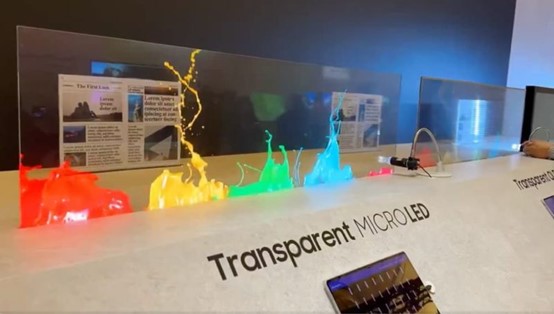
Samsung’s first-ever transparent Micro LED display (photo credit: Massimo)
Moreover, the display is thin, measuring only about 1 cm. With high pixel density, the presented images are impressively clear. As Micro LED outperforms other display technologies in terms of brightness, Micro LED displays are less likely to be affected by ambient light compared to transparent OLED models. The company even added an image layer behind the transparent screen to achieve three-dimensional effects , aiming to shape the future as part of the “AI for All” life.
The company did not reveal any detail on how much it would cost and when it will break into the retail market.
Leading Foldable Technology
At CES 2024, Samsung Display put great emphasis on the use of advanced foldable technology in various scenarios for smartphones.
The company showcased the Flex In & Out™ Flip, a foldable prototype that can be folded 360 degrees. Unlike the existing in-folding design that requires a second panel on the outside of the device for users to check information in the folded mode, the Flex In & Out™ Flip only requires a single display for information viewing, making the device lighter and thinner. Notably, the device is compatible with various devices including smartphones and tablets. The Flex product line also comes with a lightweight version, the Flexible Limple, capturing wide attention from media and visitors. Emphasizing lightweight and easy-access design, the display allows users to check time, make payments, and reply chat messages in the folded mode.
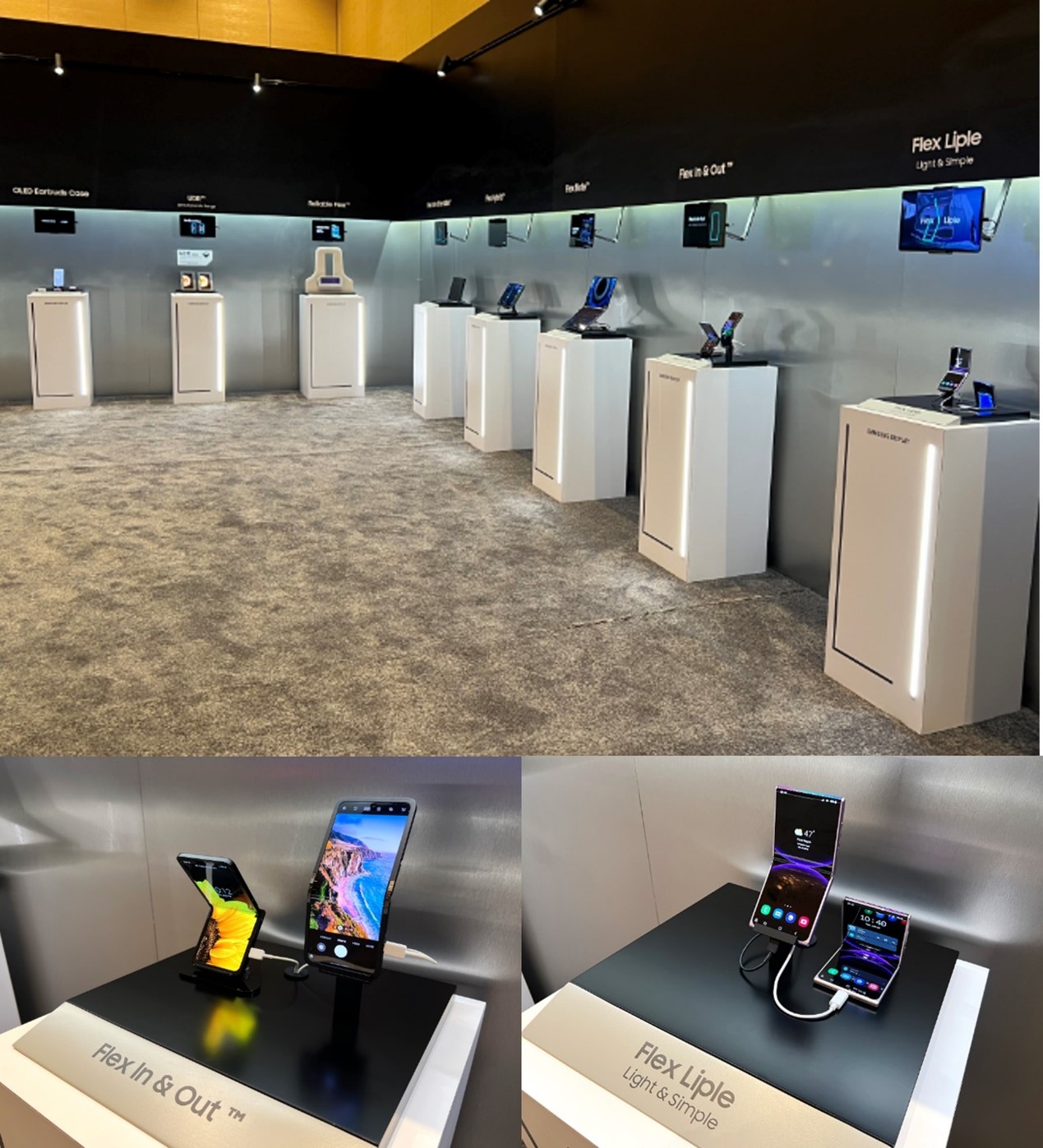
Folding technology showcased at an exhibition room, including the Flex family (photo credit: Samsung Display)
The Rollable FlexTM is a special screen that can be expanded up to five times the original size when unrolled, simulating the action of unrolling a scroll, while the Flex Hybrid combines both foldable and slidable technologies. The latter allows users to not only fold the device easily but expand the display size by just sliding.
OLED Displays for Vehicle Interiors: Optimized Space Utilization
As the automotive market is considered the most promising sector for panel applications, Samsung Display debuted its Flex Note Extendable™ that combines foldable and slidable technologies specifically for vehicle interiors. The display measures 11 inches when fully folded. When one side is extended, it expands to 13.8 inches (aspect ratio = 10:9), and when the other side is pulled out, its size increases to 17.3 inches (aspect ratio = 4:3). With flexible size adjustments, it can serve as a laptop inside the car or an extended display for watching movie.
Moreover, displays based on this technology can be hidden in different parts of the car when needed. For example, the company showcased a roll-up tablet that can be kept inside the front passenger headrest and lifted up to play video contents, exemplifying a futuristic design for flexibility and convenience.
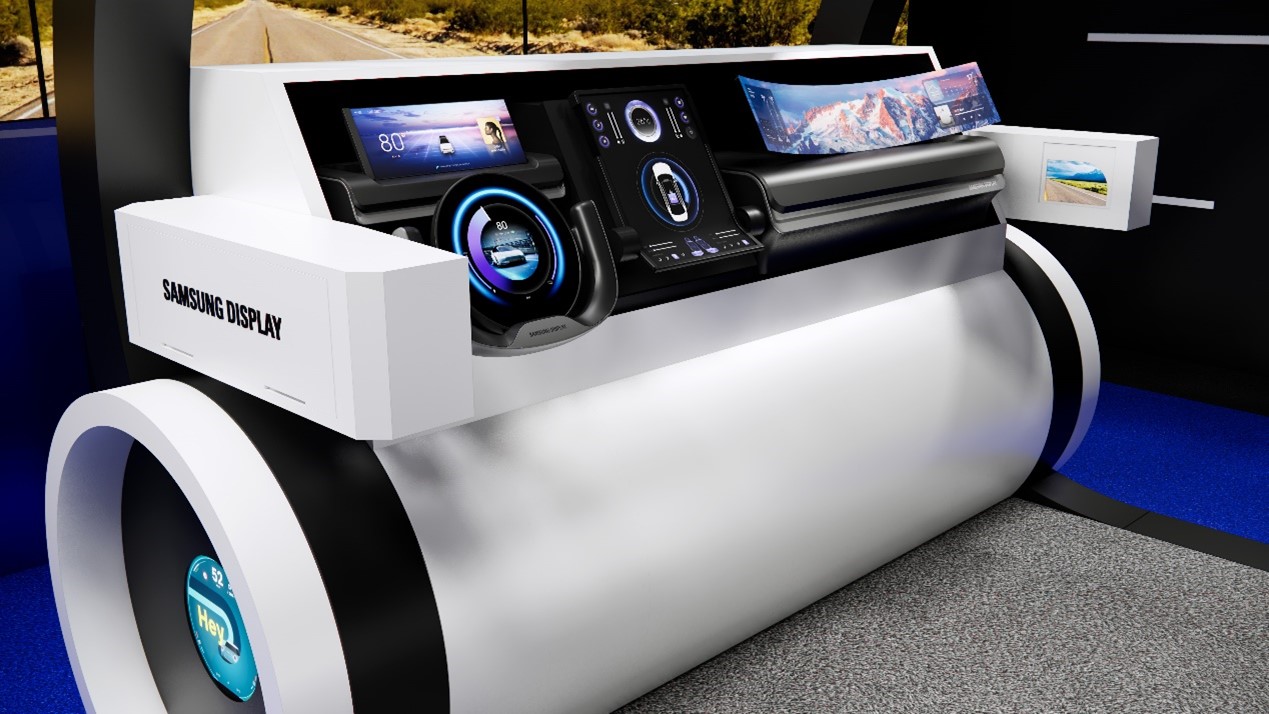
OLED displays designed for vehicle interiors (photo credit: Samsung Display)
OLED Products for the IT Sector: Diverse, Smart Design
Following the shifting trend from LCD towards OLED, Samsung Display demonstrated its OLED strength at CES 2024.
For the IT sector, the company presented a piece of eye-catching 8.6-gen OLED mother glass that is nearly 3 m high. The glass, measuring 2290 x 2620 mm, is the largest of its kind with a size of more than twice than the previous 6-gen model. Specifically, the 8.6-gen mother glass allows the manufacturer to produce 88 panels for 14" laptops simultaneously, thereby ensuring better production efficiency at a lower cost.
Samsung Display also exhibited ultra-thin OLED panels that are only 0.6 mm thick, similar to a business card and only one third of an average LCD panel. Technically, the display maker achieved such a slim and lightweight design (cutting the weight by over 60%) by removing one glass sheet from the regular OLED structure, which requires two sheets in most occasions. Additionally, the company applied 100% oxide TFT substrates to reduce the refresh rate to 1 Hz, enabling significant cost savings.
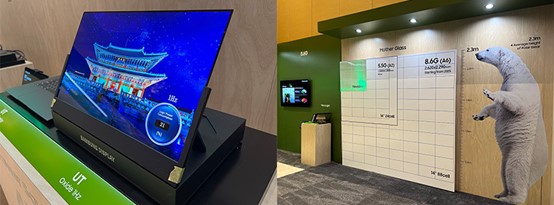
The ultra-thin OLED panel (left) and 3m tall mother glass (photo credit: Samsung Display)
Third-Generation QD-OLED Technology
Just one year after releasing its second-gen QD-OLED, Samsung Display announced the third-gen version this year, demonstrating the use of advanced panel drive technology and artificial intelligence (AI). The manufacturing process was refined with the use of the AI algorithm (Quantum Enhancer) and precise pico inkjet process. There are three things the company wants to bring to users through QD-OLED: greater brightness (>3,000 nits), higher durability (i.e., longer lifetime), and better sharpness of images (higher PPI and refresh rates). The third-gen technology allows the brightness of each RGB chip to increase significantly, about 50% stronger than the last year’s model.
Regarding monitor applications, the exhibited 31.5-inch QD-OLED monitor boasts a pixel density of 140 PPI—comparable to the image quality of a 65-inch 8K TV—and a refresh rate of up to 240Hz. Alternatively, the 27-inch panel features an impressive refresh rate of 360Hz, the highest among mass produced models. Not only do these monitors serve for entertainment purposes (e.g., gaming), but they are ideal for professional use such as video production and healthcare applications.
The latest OLED TV series made its debut during the event. The flagship S959D is powered by a QD OLED panel, which is 20% brighter than its predecessors. The anti-glare TV comes with an optimized low-reflection coating, boasting reduced glare while maintaining image sharpness.
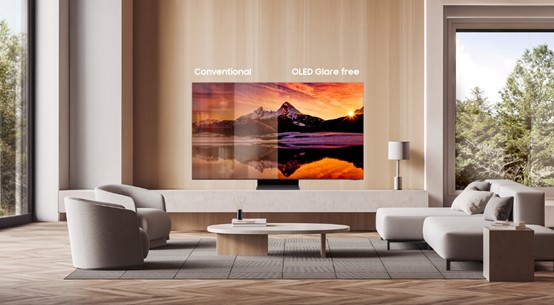
S95D is glare free, featuring higher brightness while maintaining image sharpness (photo credit: Samsung Display)
Micro OLED as Core XR Technology
During the event, Samsung Display unveiled Micro OLED displays tailored for the extended reality (XR) market. For instance, the company presented an RGB display—based on the process of using organic materials to silicon wafers—boasting ultra-high definition and μm-grade pixel density. The RGB OLED process allows red, green and blue diodes to be separately deposited without the use of a secondary light source, enabling extremely high resolution. Despite their small size, the Micro OLEDs, each measuring only 1.03", are comparable to a 4K TV when it comes to image reproduction capabilities.
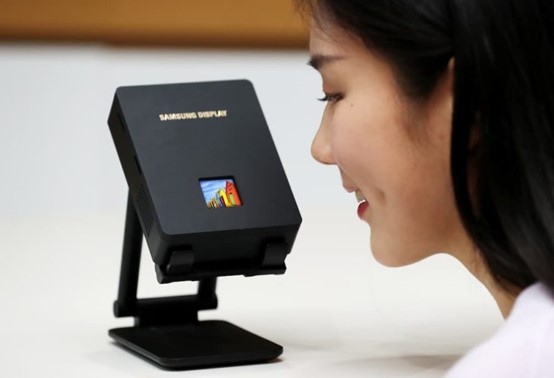
Samsung’s Micro OLED display tailored for XR headsets (photo credit: Samsung Display)
After being acquired by Samsung Display in October last year, eMagin demonstrated the application of its Micro OLEDs to various devices, such as a military helmet and a pair of nigh vision goggles at the dedicated XR exhibition space.
(Author: Jane )
Source: Samsung Display Newsroom
TrendForce 2023 Micro LED Market Trend and Technology Cost Analysis
Release Date: 31 May / 30 November 2023
Language: Traditional Chinese / English
Format: PDF
Page: 160 / Year
TrendForce 2024 Global LED Video Wall Market Outlook and Price Cost Analysis
Release Date: 28 September 2023
Language: Traditional Chinese / English
Format: PDF
Page: 273
If you would like to know more details , please contact:





 CN
TW
EN
CN
TW
EN











